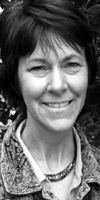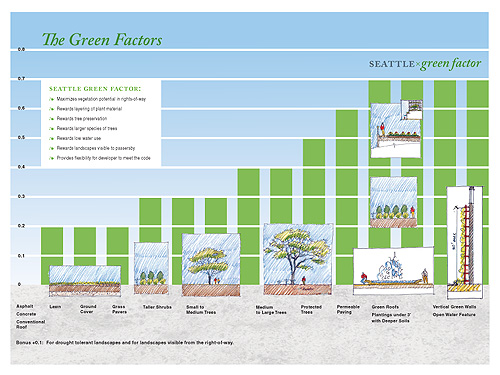
Surveys
DJC.COM
April 5, 2007
How landscaping is greening up Seattle
The Berger Partnership

Satterthwaite
|
Just a few years ago, proposing a green design to a client was met with a quizzical look or sometimes even hostility. But with the implementation of Seattle’s Ordinance 122311, effective last January, the Seattle Green Factor (SGF) provides basic goals and measures for architects, landscape architects and developers to increase the amount and quality of urban landscaping in dense urban areas with greater design flexibility.
So what makes a city green? Modeled after the Berlin Biotope Area Factor introduced in 1994, the SGF is similar to urban planning parameters used in development planning, such as the gross floor area and the floor space index, which regulate the dimensions of use structures. It expresses the area portion of a land plot to serve as a location for green space or assumes other functions to enhance environmental qualities.
The SGF requires commercial parcels in neighborhood areas to be the equivalent of 30 percent vegetated using a matrix of landscape strategies, such as green walls, rain gardens, permeable paving and planted layers of vegetation and trees.
Maximizing the green factor
The SGF strategies are weighted and expressed as a ratio according to their ecologically effective land area of development. The ecologically effective area is defined as the area of a development that is contributing to ecosystem function through stormwater drainage or habitat. In principle, design strategies that promote layering of plant material, low water use, or propose large or protected trees are given a higher score based on how much they contribute to ecosystem function.
For example, design strategies that may incur more initial expense — such as permeable paving, vertical greenery and green roofs — are rewarded with higher value points of 0.6 and 0.7 than less expensive lawns or grass pavers at 0.2. Bonus points can be achieved by specifying drought-tolerant species and landscapes visible from the right of way. The rating for each feature is then multiplied by the total area of the development, giving an ecologically effective area. This ecologically effective area is then divided by the total area of the development, resulting in the final green area score. The city of Seattle set the minimum standard for this score to be 0.3.
How it works
When a new project is proposed for development in Seattle’s commercially zoned areas, applicants must demonstrate how they intend to meet the new landscaping requirement. An electronic worksheet is available for download at the Seattle Green Factor Web site (http://www.seattle.gov/dpd/greenfactor). This tool helps applicants calculate their score.
The worksheet keeps a running score so applicants can test different landscaping arrangements to meet the requirement. Applicants will submit the worksheet, along with a plan showing landscape areas and a chart calling out planting areas and how the score was achieved.
Not just an aesthetic
The “green cities” movement argues that nature should be allowed to permeate the built environment, as a necessity rather than a luxury. Biodiversity can deliver important environmental, social and economic benefits. Ecological benefits such as microclimate control, flood prevention, air conditioning and pollution control are just a few of the many advantages. Natural green spaces also improve the quality of life by encouraging greater social interaction and increased health and well-being.
Strong national and local environmental policies are shaping the future of our cities. With a clear focus on sustainability, we can view growth and development as an opportunity to create sustainable, attractive and livable developments. The Seattle Green Factor gives developers flexibility in achieving the minimum requirements, thus providing opportunities for innovation and allowing cities to continue to densify.
Jan Satterthwaite, ASLA, is a LEED Accredited Professional and associate project manager for The Berger Partnership. In addition to her interest in ecologically responsible design, she is an avid bicycle commuter and has 17 years of practice as a public artist.
Other Stories:
- Celebrate National Landscape Architecture Month
- Add value to your team with a landscape architect
- Making freeways more than just pavement
- Designing playgrounds for the next generation
- UW team transforms garbage into gardens
- Park design gets a boost from street skaters
Copyright ©2009 Seattle Daily Journal and DJC.COM.
Comments? Questions? Contact us.
